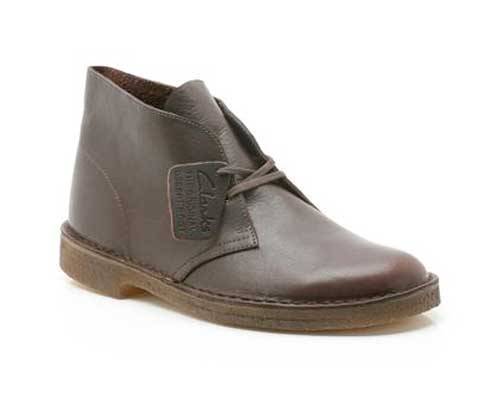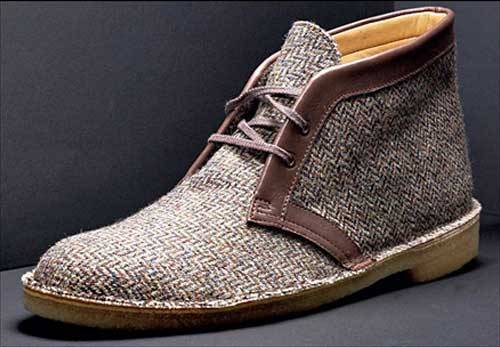
Nathan Clark, of the Clarks family, noticed that Army officers in Burma were wearing “crepe-soled rough suede boots” as part of their casual attire. The officers had discovered that these tidy boots were hard-wearing and durable, but also light weight and very comfortable. Clark found that the boots were being made and sold in the bazaars in Cairo. The design seems to be based loosely on the style of the Dutch voortrekker boot that was introduced to Western Desert warfare by the South Africa division of the Eighth Army.
On returning to Somerset, England in 1949, Clark and pattern-cutter Bill Tuxhill recreated the super comfortable construction; a simple two-piece upper body and crepe sole. The boot was formed on a round-toe last.
The desert boot had success in Italy and France and was later released in England and the US. In 1950 the Desert Boot made its American debut at the Chicago Shoe Fair.
Desert Boots became fashionable in Beatnik Culture, they w e re later adopted by Sixties Mods who wore them as part of both smart and casual clothing outfits. In 1967 when the Deputy Leader of the House of Lords, Lord Shackleton, return ed from Aden wearing a pair of locally made desert boots. On his next visit to Aden, he to ok with him orders from several Government ministers for duplicate pairs: The Popularity of the Desert Boot stretched far beyond the working class youth. Desert Boots carried on through to the Mod Revival era of the Seventies and Eighties becoming a true Retro Mod Classic.

The Mod look is still strong today; Paul Weller and Liam Gallaher sport desert boots regularly, the former even releasing his own boots in his Pretty Green clothing line.
In its 60 year history, the Clarks Desert Boot has sold more than 12 million pairs worldwide; a success which no doubt has something to do with the pedigree endorsement by noteworthy names such as Bob Dylan, The Beatles and Oasis. It’s fair to say that Steve McQueen in The Great Escape was a big influence in my young life, and look, here he is sporting a pair of Clarks Desert boots.

The Desert Boot design has been adapted, copied and revamped many times, often with success. Marks and Spencer introduced desert boots as part of a revamp of their men’s fashion department in 1970. The look combined a navy blazer, Scottish tweed trousers, a button down shirt and a silk paisley scarf.
In August 2009 Clarks Originals celebrated 60 years of the Desert Boot, introducing six off-the-wall designs; three for men and three for women, each representing a decade in boot history.
As far as I can tell, these limited edition boots aren’t available from Clarks anymore and a cursory browse of EBay heralded no results. Some of the styles are a definitely an acquired taste, however if you can track down a pair in good quality, snap them up; they’re probably worth a chunk of change. If you’re very lucky, you might even bag the souvenir booklet that comes with each pair; ‘Six Decades of Looking Forward to the Past’ - plus an exclusive 60th anniversary key ring which is made from the same materials as the boot.

It’s a classic design, a beautiful shape and very, very comfortable. Most importantly, the Desert Boot is very practical and can be worn with almost any outfit. There are style aficionados that would say that the Desert Boot cannot be worn with a suit. This is wrong. It’s true that the suit is sleek, and Desert Boots are more casual, however Desert Boots curb the formality from a suit. Worn with the right attitude it can work well.
I got a pair of Clarks Ebony Vintage Desert Boots for my 24th birthday, they cost about £70. I wore them almost every day for about eight months and loved them dearly.
After eight months the crepe soles began to wear smooth from use; this made walking on any wet surface (damp pavements, wet tarmac or snow) extremely treacherous. The soles lost almost all traction and they actually became dangerous to tread the streets in, I was slipping and sliding all over the place on my daily walk to work: At times I had to plan my route along the street, making sure that I walked only on surfaces that caused friction; such as rough tarmac and cobbles.
In hindsight, I should have gone to a cobbler, who could have, no-doubt, repaired
the soles with a quick and cheap alteration.
I love Desert Boots. The design hasn’t changed in over 60 years, testament to how great they are. I might just get my classic, beaten up old pair repaired for this summer. Then again, I might just splash out on a new pair.
Desert Boots = Good Clobber.
khwankhaw reblogged this from goodclobber
khwankhaw liked this
 petegans liked this
petegans liked this inthecac reblogged this from goodclobber
themessmaker-blog liked this
davidalexanderadams reblogged this from goodclobber
goodclobber posted this
















